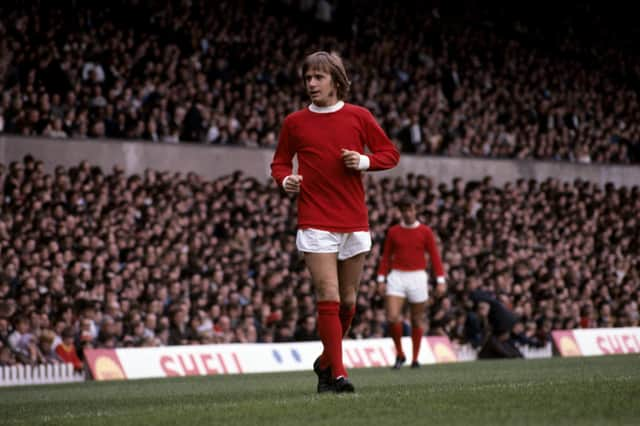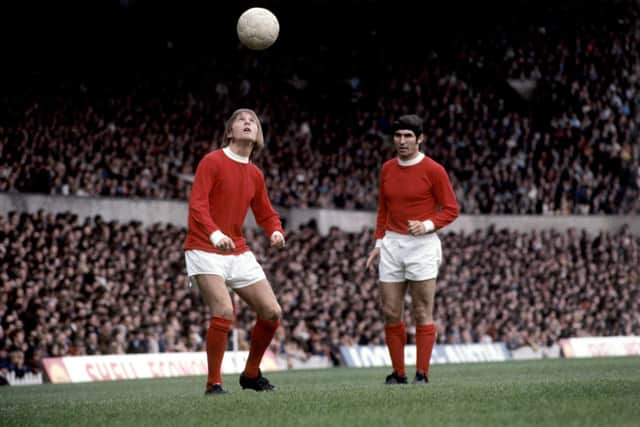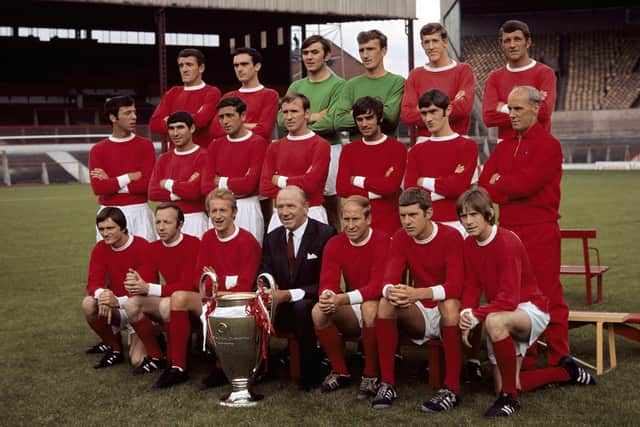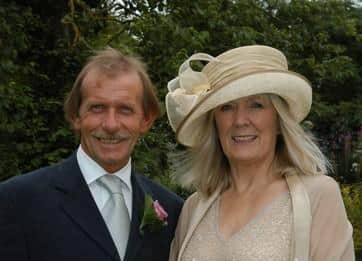Interview: Aberdonian John Fitzpatrick on making history as Manchester United’s first substitute and trying to tame best mate George Best


It might amount to treason to suggest it, but Denis Law was not irreplaceable. John Fitzpatrick knows this better than anyone. He had the unenviable task of coming on for the injured Law during Manchester United’s otherwise forgettable 5-1 defeat by Spurs in October 1965.
This switch was notable for two reasons. Not only was an Aberdonian replacing an Aberdonian, perhaps exchanging a quick ‘fit like?’ as they passed. They were also performing Manchester United’s first-ever substitution in a competitive match.
Advertisement
Hide AdAdvertisement
Hide Ad“Imagine replacing my hero!” says Fitzpatrick now. “I was almost embarrassed. I used to look for his name in the evening paper in Aberdeen. And then to end up playing with him was unbelievable.”


“It’s not fair!” bemoaned the critics when this innovation was implemented. There was considerable resistance from those who felt that bringing substitutes into the equation would have a negative impact on the game. Imagine what these Luddites would say now? Last month Manchester United became the first British club to make a quintuple substitution during the course of their 3-0 victory over Sheffield United. The rule change has been temporarily applied for the Covid-19 era amid concerns about the players’ fitness after such a long lay-off. Now it looks set to remain in place next season – Fifa has permitted the change until the end of the 2020-21 campaign, once again eliciting a mixed response.
The subject of pioneering substitutes seems especially relevant. Pat Quinn’s death earlier this week reminded us that he holds the title of Hibs’ first sub after replacing Joe Davis in a 5-1 defeat by Clyde in November 1966.
And then there’s Fitzpatrick. He and Law were spotted by the same north-east scout, the local legend Archie Beattie. There was a clutch of Aberdeenshire lads who made their way to Manchester United around this time, including Ian Moir, a talented winger who lost his way slightly, Ian Donald, who later became Aberdeen chairman, and Alex Dawson, the forward who died yesterday at the age of 80.
“I was playing for the Frederick Street school team,” recalls Fitzpatrick. “Naturally you are hoping scouts will be there to see you. I had been playing well at the time. Archie Beattie came up to me after the last game of the season, told me who he was, and asked if I’d like to go down to Man United…


“You won’t believe it, but they were the team I supported – along with Celtic in Scotland. I had heard some clubs were interested in me. But I never thought it would be them. Archie met up with my dad a couple of weeks later and we arranged to go down to Old Trafford. The rest is history…”It almost wasn’t.
European Cup final heartbreak
After a successful trial he was told by Manchester United to get back up the road and prepare for a new career at the biggest club in the land. Fitzpatrick duly broke his ankle while playing for Aberdeen Lads’ Club Thistle against Hawthorn United the following weekend.
A letter from Joe Armstrong, the Manchester United chief scout, soothed any fears they might retract the offer. A club healing after the Munich air crash was still determined to exhibit class. Fitzpatrick’s Manchester United career was only postponed. He was a member of the side which won the FA Youth Cup in 1964 along with great friend George Best. They even grew their hair long together from the short-back-and-sides look both sported in that fresh-faced team’s photograph.


Advertisement
Hide AdAdvertisement
Hide AdFitzpatrick proved handily versatile. Although normally a defender, one of his greatest games was a testing European Cup quarter-final against Gornik in 1968. He wore the No 7 shirt normally associated with Best in front of a partisan crowd of over 100,000. United won 2-0 in arctic conditions. Matt Busby later described it as one of the finestnights in the club’s history. “I feel the warmth of our dream living on,” the manager said. “I’ve a feeling this is our year.”
And so it proved. But Fitzpatrick was left out of the side that defeated Benfica 4-1 at Wembley. Veteran defender Bill Foulkes, who scored in the 3-3 semi-final second-leg draw with Real Madrid that sealed United’s place in the final, retained his place.
“He was a Munich survivor and coming towards the end of his career,” says Fitzpatrick. “There was no way Matt Busby was not going to include him, understandably. Of course, this was devastating for me personally not to be involved. But I got a medal because I contributed to the games leading up to it. It was a nice touch from Matt.”
Ideally, one would like to be sharing a glass of something dark and fruity with Fitzpatrick, who turns 74 next month, as he relates his remarkable story.Lockdown restrictions are easing. Alzheimer’s, on the other hand, has started to tighten its grip on Fitzpatrick, squeezing the most recent memories from his mind. His Manchester United days can seem more vivid to him than what he did yesterday. However, there’s one moment that he almost wishes he was no longer able to recall.
He admits he always liked a tackle. He is often described as “fiery” and “controversial” in contemporary newspaper reports. He was sent off for retaliation in the European Cup semi-final first leg v AC Milan in 1969 as Manchester United’s defence of the trophy floundered.
A game against the Leeds United of the time was never likely to be a place for shrinking violets. And opposite man Johnny Giles was among the more uncompromising members of that Leeds side.
“It was a bouncing ball,” recalls Fitzpatrick. “And with me being a young, enthusiastic boy I was going in to win the tackle. I put my leg out and he was right over the top. That was it. That was me. Finished.”
He was 26 years old.
The tackle by Johnny Giles
There were attempts at a comeback, which was something Giles himself pointed out when the incident returned to the news agenda more than 30 years later after the publication of Roy Keane’s autobiography. Giles criticised the book – and Keane, and by extension ghostwriter, Eamon Dunphy – for its unapologetic depiction of the tackle that all but finished Leeds United player Alf Inge-Haaland’s career. Dunphy pointed out that Giles should know all about the often brutal realities of football – he had put Fitzpatrick out of the game after all when breaking his leg.
Advertisement
Hide AdAdvertisement
Hide AdDunphy even alleged Giles had told Nobby Stiles, who was his brother in law and a member of the opposite team, his plan earlier in the match. Perhaps surprisingly, Fitzpatrick sided with Giles. He confirmed his leg was not broken. And that he played on. “It was a 50/50 tackle and I came off the wrong side of it,” he said. Nevertheless, Giles did not seek to contact Fitzpatrick, as might have been expected given the eventual consequences of the challenge, fair or otherwise.
Fitzpatrick kept on training in the hope he could return. But not even a visit to Sir Henry Osmond-Clarke, surgeon to the Queen, could save his career. Fitzpatrick’s last game was a 2-0 defeat against Wolves at Molineux on 16 September 1972 under Frank O’Farrell. Providing some illustration of the extent to which Manchester United were declining, they had scored only four goals in their opening nine league games, up to and includingWolves. They narrowly avoided relegation that season but went down at the end of the next campaign. Fitzpatrick was already back in Aberdeen.
“My contract was up anyway,” he says. “I was going to get offered a new contract. I think that is one of the reasons why they gave me a bit of money, which was unbelievable.
“The phone rang. Whenever the phone rang and you were asked to go and see Matt Busby, you wondered what you had done wrong. I knocked on the door and in I went. He said: ‘how are you feeling?’ And I obviously said I was upset at the fact I won’t be able to play again. He said: ‘well that’s for you’. It was a cheque for £20,000. He was that type of man.
“I had to start afresh again. A new life. Not many clubs would do that for a young player. I went home. I could not stand it. If I could not play for Man United I could not stay.”
He invested some of the money in a wine business – John Fitzpatrick Wines. He also managed in the Highland League for short spells at Huntly and Buckie Thistle. “My heart was never really in it,” he says.
Involvement with wine has proved more long-lasting. He set up another business, The Wine Kist, which is now run mostly by his wife, Barbara, a fellow Aberdonian who he met on a trip home to the city from Manchester United, and Claire, their daughter.
Fitzpatrick likes his wine as he did his tackles – powerful and full-bodied. What would we be sipping if sitting in his home in Cults, near to where Alex Ferguson once lived when he was Aberdeen manager? “A Cotes du Rhone is inexpensive and if you are really wanting something decent and spending money, a Nuits St Georges,” he says.
Advertisement
Hide AdAdvertisement
Hide AdPlaying snooker with George BestMention of George, and wine, inevitably takes us back to… George Best. “Me and Bestie used to enjoy a glass of wine together,” he says. “He was a red wine man. As I am.”
They were close enough for Fitzpatrick to feel a responsibility to warn Best that he might be better reining things in. The trouble was, he was still able to perform on the park.
This made it more difficult to explain what the benefit might be if he cut back on all the carousing.
“He was enjoying life,” says Fitzpatrick. “I kept saying: ‘listen, you have to stop doing what you’re doing, George’. And he would say: ‘yes, I will do that Fitzy’. But he never did. He was getting away with it on the park. He was playing brilliantly. But things gradually went wrong. It was up to him to sort himself out. I tried a few times. Unfortunately, it did not work. We spoke about it later when he had packed up. But what a waste of talent.”
After training we used to have a wee bit of lunch and then go to a snooker club. We did that practically every day. A bunch of us all went together. We played snooker until about 5pm, went home and had tea and went out again. You had to keep yourself occupied! To be perfectly honest I had a drink but nothing like George got involved in!
“What you have to remember, he was one of the great players in the world,” adds Fitzpatrick. “He was. He was absolutely brilliant. Manchester United were not the same without George Best. It’s as simple as that. He was the star player. Even towards the end he was still performing but he could not do it quite like he used to. I used to say you will have to cut it out: ‘OK, Fitzy I will do it’.
“But it was a disease.”
Fitzpatrick naturally views Best’s drink-related decline through the prism of his own fate, which he was equally helpless to avoid. People say Best wasted his talents. Fitzpatrick wasn’t given the opportunity to explore that pitfall.
He still managed to make 141 appearances for Manchester United and scored ten goals. It would have seemed the tallest of all tales if a local fisherman had told him, when he was a child in Footdee, that this is what he would grow up to do. “I was just a wee lad from a fishing village in Aberdeen,” he says.
Advertisement
Hide AdAdvertisement
Hide Ad“I was lucky enough. I look at it this way – I played for Manchester United. OK, I got injured but people get injured playing football, don’t they?”
And providing further satisfaction is knowing his 13-year-old grandson, Louis Gray, is currently making progress in following in the footsteps of his once famous grandfather. Louis, a defender, has been signed up by the Dundee FC academy. The recent news that the club are intending to maintain all youth operations despite other cutbacks has been greeted with particular delight within one family with a rich football heritage in Aberdeen.
A message from the Editor:
Thank you for reading this story on our website. While I have your attention, I also have an important request to make of you.
With the coronavirus lockdown having a major impact on many of our advertisers - and consequently the revenue we receive - we are more reliant than ever on you taking out a digital subscription.
Subscribe to scotsman.com and enjoy unlimited access to Scottish news and information online and on our app. With a digital subscription, you can read more than 5 articles, see fewer ads, enjoy faster load times, and get access to exclusive newsletters and content. Visit https://www.scotsman.com/subscriptions now to sign up.
Our journalism costs money and we rely on advertising, print and digital revenues to help to support them. By supporting us, we are able to support you in providing trusted, fact-checked content for this website.
Joy Yates
Editorial Director
Comments
Want to join the conversation? Please or to comment on this article.